Localization Studies for Hyperparathyroidism
Hyperparathyroidism is when a person’s parathyroid glands produce too much parathyroid hormone (PTH). The parathyroid glands are four rice-sized organs behind the thyroid. Since PTH helps regulate the amount of calcium and phosphorus in the blood, hyperparathyroidism (HPT) can lead to complications.
Some HPT patients show symptoms like kidney stones, achy bones, and upset stomachs. But others show no symptoms at all. A case of HPT is often suspected when a routine blood test shows elevated calcium levels.
Further laboratory testing can confirm a diagnosis of hyperparathyroidism. But this is only the beginning of a patient’s diagnostic journey. The only way to treat the most common type of hyperparathyroidism — primary HPT — is surgery to remove the enlarged parathyroid gland. Health providers must use localization studies for hyperparathyroidism to find the malfunctioning gland — or glands.
A patient may have one abnormal gland called a parathyroid adenoma, which is the case for roughly 85% of HPT cases. Or, they may have two or more adenomas (multiple parathyroid adenomas, which represent 10% of cases). Finally, all four glands could be abnormal, indicating parathyroid hyperplasia, which affects 5% of HPT patients.
The only way to know how many glands are affected is with specialized parathyroid scans.
Types of Localization Studies for Hyperparathyroidism
Several different types of localization studies help medical providers identify the location and condition of enlarged parathyroid glands. Each one has unique strengths, so we’ll look at them individually.
Ultrasound
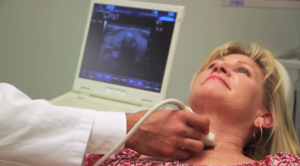 Ultrasound imaging is a reliable way to identify an abnormal, enlarged parathyroid gland. Ultrasound uses harmless sound waves to look at the structures under the skin, including the thyroid, parathyroid, muscles, and blood vessels.
Ultrasound imaging is a reliable way to identify an abnormal, enlarged parathyroid gland. Ultrasound uses harmless sound waves to look at the structures under the skin, including the thyroid, parathyroid, muscles, and blood vessels.
Ultrasound should always be the first study to look for an abnormal parathyroid because it is fairly accurate but does not expose the person to any type of radiation, unlike a sestamibi parathyroid scan or CT scan. An ultrasound will likely to show the abnormal parathyroid when performed by expert radiologists, endocrinologists, or surgeons.
In the past decade, ultrasound has become available in doctor’s offices. Most parathyroid specialists have an ultrasound machine. This means they can do a scan for a patient as soon as laboratory results suggest a diagnosis of hyperparathyroidism. Parathyroid ultrasound scans make it easier for providers to begin treating patients immediately.
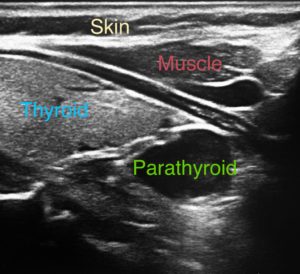 Ultrasound can show the exact dimensions of the:
Ultrasound can show the exact dimensions of the:
- Thyroid gland
- Enlarged parathyroid glands
- Vessels feeding the enlarged glands
- Carotid artery
- Lymph nodes
- A portion of the thymus that is in the neck
- Breathing tube (trachea)
- Surrounding muscles
The ultrasound image here shows a large parathyroid adenoma just below the lower edge of the thyroid gland, roughly an inch and a half deep in the skin. However, ultrasound does have its limitations; it cannot see behind bone or cartilage, so if a parathyroid adenoma is hiding behind the collar bone, chest bone, breathing tube, or voice box, a more sophisticated parathyroid scan is needed.
Expert parathyroid surgeons perform an ultrasound to do three things:
- Confirm the size and location of the abnormal parathyroid.
- Assess the relationship of the abnormal gland to adjacent structures (thyroid, carotid artery, recurrent laryngeal nerve).
- Measure how far the affected gland is from the surface of the skin.
This information helps a surgeon plan the surgery and make it safer. In cases when both an ultrasound and sestamibi parathyroid scan have been done, providers can identify an abnormal gland with an accuracy greater than 90%. When a patient comes to the CENTER for Advanced Parathyroid Surgery, Dr. Larian repeats the ultrasound for reinforced accuracy throughout treatment.
Pros of Parathyroid Ultrasound
- Highly accurate.
- Can show the anatomy of the neck and create a roadmap for the surgeon to access the abnormal parathyroids while avoiding important structures.
- There is no radiation exposure for the patient.
- Can be done in the office.
Cons of Parathyroid Ultrasound
- Hard for the surgeon to visualize the anatomy when the procedure is done at another imaging center and not by the surgeon.
- Does not show parathyroids that are hiding behind the voice box, breathing tube, chest bone, or collar bone.
- Patients that have thyroid inflammation (Hashimoto’s thyroiditis) will often have lots of enlarged lymph nodes that can be confused on ultrasound for an abnormal parathyroid gland.
Sestamibi Parathyroid Scan
A parathyroid sestamibi scan is another effective way to locate a parathyroid adenoma.
In a sestamibi parathyroid scan, the patient is given a small amount of radioactive dye (sestamibi radiotracer) that is quickly absorbed by the mitochondria (the engine) of highly active cells as in an abnormal functioning parathyroid gland and the thyroid.
In the following few hours, the material leaves the thyroid quickly and the parathyroid slowly. So, an initial scan is compared to the delayed scan to identify the abnormal parathyroid. The parathyroid sestamibi scan is a complex, technical study and can have inaccurate results if done by a provider without extensive experience and training to do this scan.
Even when the study is done by expert radiologists, in a person whose PTH is over a 150, sestamibi scans can only locate the abnormal glands in roughly 85% of cases. When done without expertise, or when PTH is lower it can be much less accurate. However, there are times when the parathyroid is too small or is unable to concentrate the sestamibi. This means it won’t show activity on the scan. But a result like this does not mean there isn’t an abnormal gland, but rather that the gland is not active enough to show up in this type of study.
It’s also possible that there are multiple minimally active parathyroid adenomas or that all four glands are abnormal, and each has a low level of activity — too low to be seen on a parathyroid sestamibi scan.
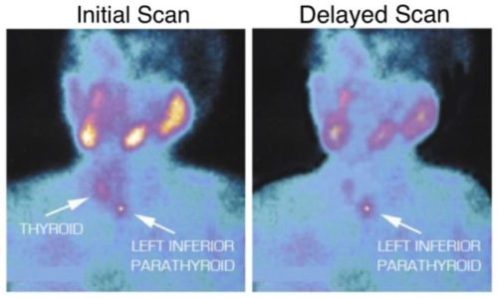
How the Sestamibi works: When the parathyroid gland is producing the PTH hormone (which is a large protein), it uses a fair amount of energy. The part of the cell that creates the energy is called mitochondria, and the sestamibi nuclear material is attracted to the actively working mitochondria. The more active it is, the more likely it is for sestamibi to attach to it. So, in the situation where the PTH levels are very high (above 150 pg/dl), sestamibi scans are most likely to be able to find the abnormal gland. When the PTH is less than 100, the likelihood that this scan will show the abnormal gland is LOW.
As can be seen from the image above, the parathyroid sestamibi scan does not show detailed anatomy. Instead, it shows the general area of the abnormal gland, which means there’s no detailed anatomic information to use for the surgery.
Parathyroid Sestamibi Scan Pros
- Very accurate when the PTH is high (PTH greater than 150 pg/dl).
- Can show parathyroids that are hiding behind the voice box, breathing tube, chest, or collar bones.
- Can find a gland that is in an ectopic location (unusual spot), as in the upper neck, or down in the chest.
Parathyroid Sestamibi Scan Cons
- Much less accurate if PTH is low (less than 100 pg/dl).
- Needs to be done by an imaging center with a lot of experience to be done well.
- Because it uses a radioactive material, the patient is exposed to radiation.
- Does not give detailed anatomic information but rather a general location of a parathyroid adenoma.
- The results can be inaccurate if there are thyroid nodules.
SPECT & CT Fusion Scan
Single-photon emission computed tomography (SPECT) is a sophisticated, 3-dimensional localization study for hyperparathyroidism. that uses the same radiotracer as the conventional sestamibi parathyroid scan. This nuclear medicine-based parathyroid scan fuses the images of a sestamibi scan with a CT scan done at the same time. This combination of images can help pinpoint the exact location of the enlarged parathyroid gland, and therefore, it has greater accuracy.
However, as with the standalone parathyroid sestamibi scan, this scan must be done by imaging centers experienced in nuclear medicine-based parathyroid scans. Just as in the sestamibi scan, a SPECT scan can miss a parathyroid tumor that is not producing a large amount of PTH. Because of this, the test is not ideal for people with a PTH level under 100. The images shown here clearly point at a parathyroid adenoma (orange dot) in the right inferior aspect of the lower neck, just above the chest bone.
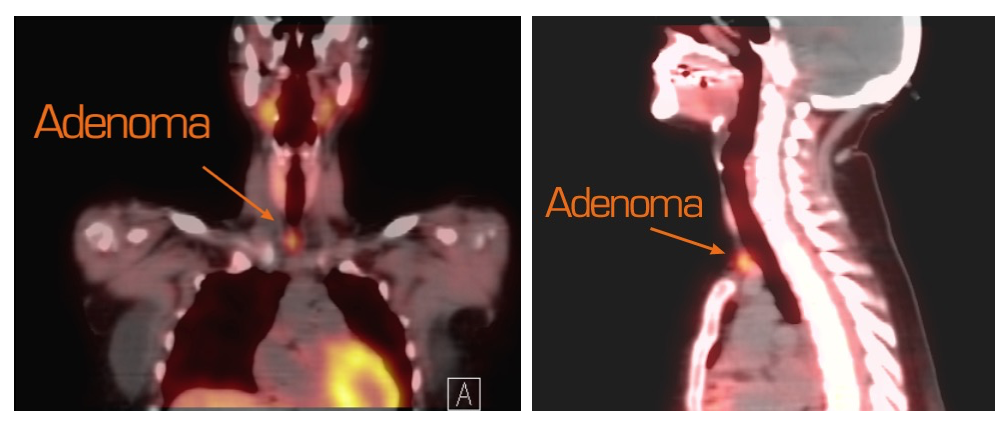
SPECT Scan Pros
- Very accurate when the PTH levels are high.
- Can show parathyroids that are hiding behind the voice box, breathing tube, chest, or collar bones.
- Can find a gland that is in an ectopic location (unusual spot), as in the upper neck, or down in the chest.
- Shows more anatomic detail than a sestamibi scan.
SPECT Scan Cons
- Much less accurate if PTH is low.
- Needs to be done by an imaging center with a lot of nuclear medicine parathyroid scan experience to be done well.
- Because it uses radioactive material as well as a CT scan, the patient is exposed to radiation.
- Thyroid nodules may affect the results of the scan.
- Less anatomic information than 4D CT scan or ultrasound.
4D Parathyroid CT Scan
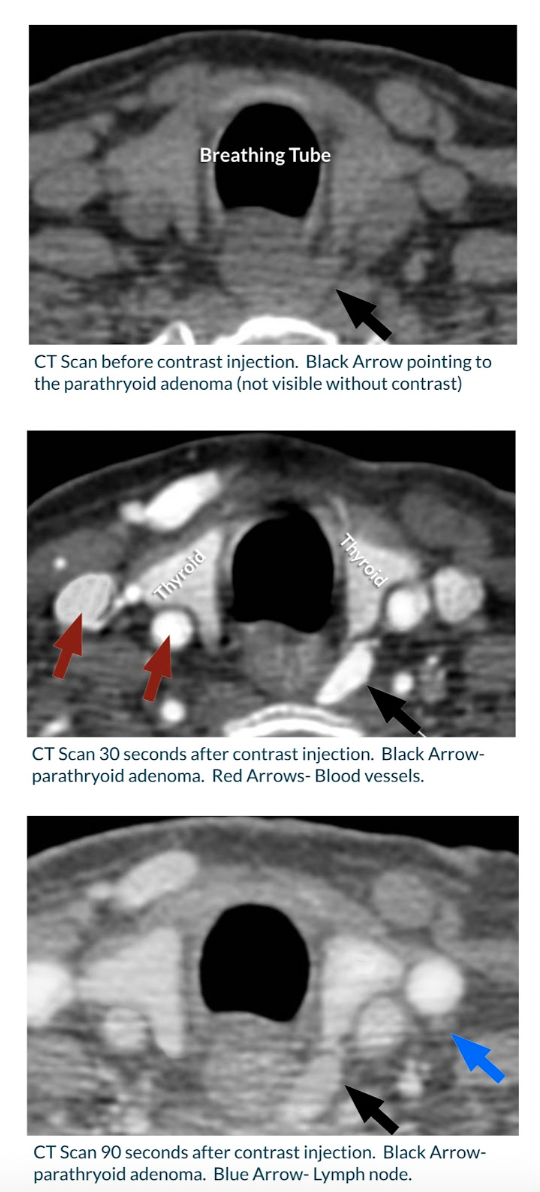
The 4D parathyroid CT scan is the newest imaging study used to locate an abnormal parathyroid. It is the most accurate of all the localization studies for hyperparathyroidism.
A 4D CT scan for the parathyroid glands works because abnormal parathyroid glands have more blood flowing into and out of them than normal glands. The thyroid gland has good blood flow as well, an additionally holds on to the to the iodine in the contrast for a long time. Lymph nodes generally have poor blood flow and does not absorb the contrast much. This is how you can distinguish between the three types of tissue.
This difference is visible when the 4D CT scan for parathyroid glands is done at different times after the contrast dye is injected into the bloodstream. This type of scan shows the anatomy in great detail, which not only identifies the abnormal parathyroid gland but also assesses it in relation to the tissue around it, including the thyroid gland, blood vessels, breathing tube, and esophagus.
The 4D CT scan for parathyroid glands will show if the abnormal parathyroid is close to the area of the voice box nerve. Even though the nerve itself is not visible, the anatomic path is well known to your surgeon. It can also show a gland that is not in the normal position (an ectopic parathyroid gland). This parathyroid scan radiology can show glands anywhere from the upper neck and down into the chest.
The 4D parathyroid CT scan can identify an enlarged parathyroid better than the other scans mentioned on this page. However, it also exposes the patient to the radiation, even though we have modified our 4D CT parathyroid scan protocol to minimize the dose of radiation. The risks and benefits of this type of parathyroid scan radiology are important to consider when it comes to younger patients.
We firmly believe that a 4D CT parathyroid scan is the study of choice in patients who have had previous parathyroid surgery and have had recurring issues with the disease. This type of parathyroid scan is also ideal for newly diagnosed hyperparathyroid patients with a negative ultrasound and any PTH levels..
4D CT Scan for Parathyroid Pros
- Highly accurate.
- Can show parathyroid glands anywhere in the neck and chest even if they are hiding behind the voice box, breathing tube, chest, or collar bones.
- More anatomic detail than a parathyroid sestamibi scan or SPECT scan.
- More accurate even when the tumor is small, and PTH levels are only slightly elevated.
4D CT Scan for Parathyroid Cons
- Exposure to radiation.
- Can also sometimes show normal parathyroid glands, which may seem abnormal to an inexperienced surgeon.
Planning Treatment After Localization Studies for Hyperparathyroidism
A parathyroid specialist can devise a treatment plan once a patient undergoes localization studies for hyperparathyroidism. The most effective treatment for primary hyperparathyroidism is a parathyroidectomy — a surgery to remove the affected gland or glands. At the CENTER for Advanced Parathyroid Surgery, Dr. Babak Larian provides expert care for patients with hyperparathyroidism. A board-certified surgeon, he has performed countless minimally invasive parathyroidectomies.
During a minimally invasive parathyroidectomy, Dr. Larian will carefully remove the offending parathyroid gland and perform intraoperative PTH testing to confirm a cure. Most cases of primary hyperparathyroidism involve the removal of one gland. In some cases, two or more glands must be removed. If all four glands are enlarged, Dr. Larian will leave a portion of one gland behind, allowing the body to have functioning parathyroid tissue. These patients may need to take supplements long-term to help them regulate their calcium and vitamin D levels.
For the overwhelming majority of primary HPT patients, however, a parathyroidectomy provides a lasting cure. Using the right localization studies for hyperparathyroidism can significantly improve the success of the surgery.
Conclusion
Like any surgery, a parathyroidectomy carries some risks, such as not finding the abnormal gland, damaging healthy parathyroid glands, and damage to the nerves that control the vocal cords. That’s why it’s crucial to find a surgeon who is board-certified in Otolaryngology — Head & Neck Surgery and has years of experience treating these cases, like Dr. Babak Larian.
Without treatment, primary hyperparathyroidism can lead to several serious complications. These include osteoporosis, kidney stones, cardiovascular disease, kidney disease, and even coma. The good news is that a minimally invasive parathyroidectomy provides a cure in approximately 97% of primary HPT patients. Dr. Larian can confirm a diagnosis and locate your malfunctioning parathyroid gland with advanced localization studies for hyperparathyroidism.
With treatment, you can avoid the debilitating complications of HPT and feel like yourself again.
Contact us at the CENTER for Advanced Parathyroid Surgery today to learn more, or schedule your consultation with our specialists.
Parathyroid Scan FAQs
Dr. Larian understands that patients often have a lot of questions about the imaging tests required for locating parathyroid tumors, and that the choice of which scan to get can be confusing. He has answered some common questions for you below to help you through this process.
Q: Can localization scans help make the diagnosis of hyperparathyroidism?
A: No, the diagnosis of hyperparathyroidism is made by laboratory findings. The scan is only to help identify where the abnormal gland is.
Q: Which scan should be the first choice?
A: Ultrasound should always be the first choice because it only uses sound waves. There is no radiation involved.
Q: Should I be concerned about radiation exposure?
A: Many patients do express some concern in regards to being exposed to radiation for parathyroid scans. First, the decision to proceed with one of the studies that use radiation (Sestamibi, SPECT, or 4D CT scan) should be only after having a negative ultrasound. Having said that, the dose of radiation in these scans is low and not harmful. Knowing the exact location of the abnormal parathyroid allows your surgeon to perform a minimally invasive focused surgery, which minimizes the scarring, trauma to the tissue under the skin, and recovery time.
Q: Where do I go for a Sestamibi SPECT scan?
A: If we are treating a patient who lives in the Los Angeles area for a parathyroid disorder, Dr. Larian will send the patient to one of the local hospitals with great expertise in performing SPECT sestamibi scans. If the patient cannot get to LA for the scan, we will recommend a reputable medical center that performs this type of scan on a regular basis. You have to ask the imaging center how often they perform a sestamibi scan and what is their success rate in identifying the abnormal gland. Less then 70% success rate is not acceptable.
Q: Do all parathyroid surgery patients need a Sestamibi SPECT scan?
A: No, Only ones that have a negative ultrasound study and have a PTH that is higher than 150 pg/dL.
Q: When would you choose a 4D parathyroid CT scan over a SPECT scan?
A: When the patient has had a negative or equivocal ultrasound study and the PTH level is less than 100 pg/dL. The chance of sestamibi or SPECT scan being positive when the PTH is less than 100 pg/dL is significantly lower, because the abnormal gland is not very active and not producing a lot of hormone, this decreases the attraction of the parathyroid to the sestamibi radiotracer, and makes it less likely to attach to it and show up on the scan.
Q: Is a high-resolution CT scan of the neck and upper chest the same as a 4D parathyroid CT scan?
A: No, the 4D parathyroid CT scan is a specialized form of high-resolution CT scan. It not only looks at a thin section of imaging of the neck and the upper chest but also at different time points after injecting the contrast dye. This allows the 4D scan to also see how the contrast that is injected in the blood flows through the tissue which can distinguish between lymph nodes, thyroid tissue and parathyroid. The ability to tell these tissues apart from each is very helpful because on a regular CT scan they can look the same.
Contact The CENTER For Advanced Parathyroid Surgery Today
If you feel as though you may be experiencing parathyroid problems and would like to speak with an expert parathyroid surgeon today, we encourage you to contact our CENTER by calling 310.461.0300 to set up an initial consultation.
Dr. Larian is an experienced parathyroid surgeon in Los Angeles with a unique knowledge in the diagnostic testing and their meaning and ramifications the patients suffering from hyperparathyroidism.









